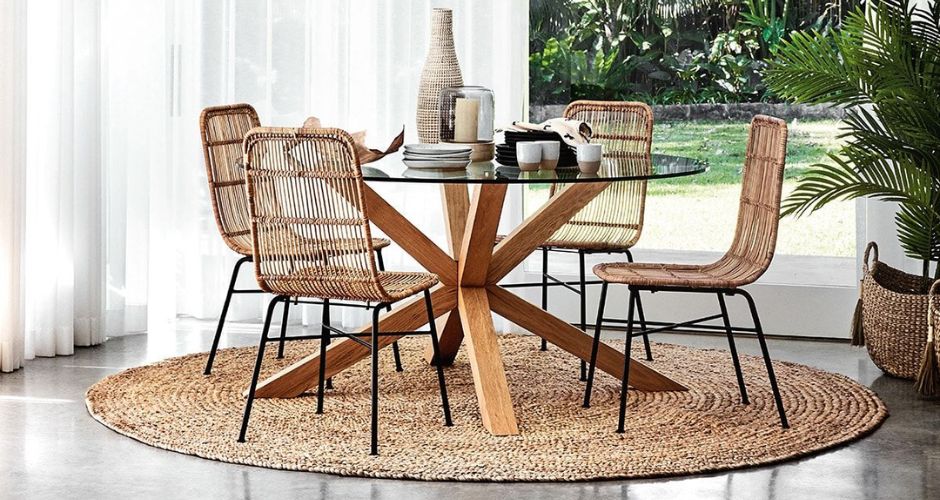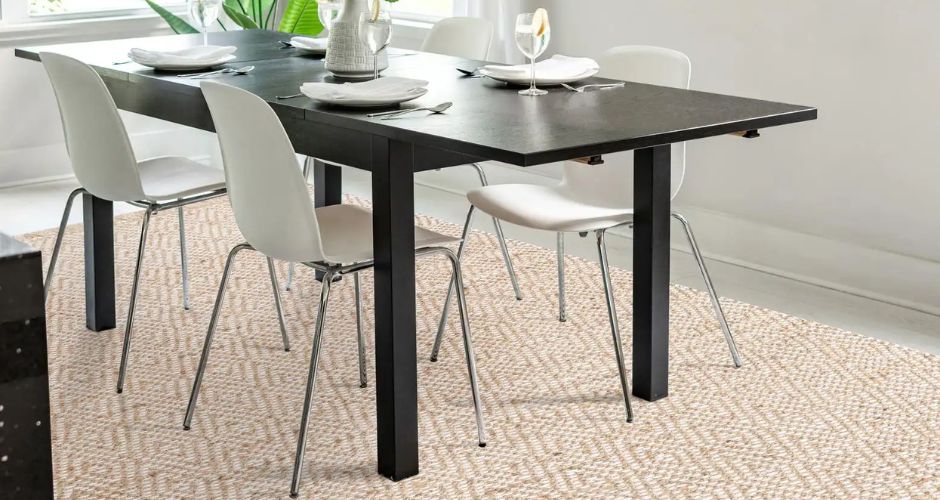Dining Room Rug Rules: Is Jute a Good Fit?

When decorating a dining room, rugs are often an overlooked element-but they play a powerful role in defining the space. A well-chosen rug can anchor your dining area, add warmth and texture, and even protect your flooring from scratches and spills.
Among the many rug materials available, jute stands out for its natural look, affordability, and eco-friendliness. But is jute the right choice for your dining room?
In this article, we’ll explore the pros and cons of using a jute rug in the dining area, offer styling tips, and help you decide whether it’s a practical fit for your home.
What Is a Jute Rug?
Jute is a long, soft, and shiny vegetable fiber that can be spun into coarse, strong threads. It’s one of the most eco-friendly rug materials because it’s biodegradable, renewable, and requires little water or chemical processing to cultivate. Jute rugs are typically hand woven or braided, showcasing a beautiful, rustic texture that brings a sense of groundedness and nature into your home.
Why People Love Jute Rugs in Home Decor
Jute rugs have become a favorite in the world of sustainable and minimalist design. Here’s why:
- Natural Aesthetic: Their neutral tones and raw texture make them incredibly versatile. They blend beautifully with boho, Scandinavian, farmhouse, and modern decor styles.
- Eco-Friendly: Jute is a natural fiber that decomposes quickly and is harvested in an environmentally conscious way.
- Cost-Effective: Compared to wool or other natural fibers, jute rugs are relatively affordable.
- Soft Underfoot: While not plush, jute rugs have a soft, earthy feel that adds comfort and warmth to hard flooring.

The Dining Room: A Challenging Space for Rugs
Before we answer whether jute works well in the dining room, let’s first consider the demands of this space:
- High traffic: Dining rooms often see regular use, particularly in homes that use the space daily or entertain frequently.
- Furniture weight: Dining tables and chairs sit on top of the rug and may scratch or dent weaker materials.
- Spill risk: This is a big one. Crumbs, sauces, wine, and coffee are all common accidents in dining spaces.
Also explore Why Every Dog Owner Needs a Sofa Protector
Is Jute a Good Fit for Dining Rooms?
✅ Pros of Using Jute in the Dining Room
- Natural Beauty
Jute’s earthy texture and understated hues offer a calming foundation for a dining room, especially if your goal is to create a cozy, organic feel. - Neutral Versatility
Jute rugs complement most dining room color schemes and decor styles without overwhelming the space. - Durability
Jute is relatively strong and can handle moderate foot traffic and heavy furniture, making it suitable under a dining table and chairs. - Eco-Conscious Choice
If you’re building a sustainable home, a jute rug is a guilt-free addition.
❌ Cons of Using Jute in the Dining Room
- Stain Sensitivity
This is the biggest concern. Jute is extremely absorbent and does not react well to moisture. Spills can cause permanent staining or even break down the fibers. - Difficult to Clean
Unlike synthetic rugs or tightly woven wool rugs, jute doesn’t tolerate vigorous cleaning. Water can cause it to brown or mildew, and it can’t be steam cleaned. - Texture and Shedding
Some jute rugs may feel coarse, and they tend to shed over time, leaving dust particles that require frequent vacuuming. - Limited Color Choices
Jute typically comes in natural tones-beige, tan, or brown. If you’re looking for bold color or patterns, you may need to consider blends or layered looks.
Learn here How to Wash Sofa Covers Without Shrinking
How to Make a Jute Rug Work in Your Dining Room
If you love the look and eco-friendly appeal of jute but are concerned about practicality, here are some ways to make it work:
1. Choose a Flatweave Jute Rug
Look for a low-profile, tightly woven jute rug. These are sturdier under chairs and less likely to trap crumbs or bunch up when moved.
2. Use a Protective Coating
Some jute rugs come pre-treated with a stain-resistant finish. You can also apply a fiber sealer spray designed for natural rugs to help repel spills.
3. Layer It Up
Layer a jute rug under a more washable, decorative rug. This gives you the best of both worlds-style, protection, and texture.
4. Pick the Right Size
Make sure your jute rug is large enough that chairs remain on the rug even when pulled out. Typically, aim for 24 inches of rug space beyond the table on all sides.
5. Vacuum Regularly
Keep your jute rug clean by vacuuming it often-especially after meals. Use a suction-only vacuum (no rotating brush) to avoid damaging the fibers.
Final Verdict: Should You Use a Jute Rug in the Dining Room?
Yes-but with caution.
Jute rugs are a beautiful and sustainable choice that can elevate the design of your dining room. However, they’re best suited for low-mess homes, adults-only households, or more formal dining areas where food spills are less frequent. If you’re a fan of their raw elegance and are willing to maintain them with care, a jute rug can absolutely be a smart, eco-conscious addition to your dining space.
Summary: Dining Room Rug Rules for Jute
| Factor | Verdict |
| Style | ✅ Excellent-natural, minimalist, and warm |
| Durability | ✅ Good-strong enough for dining chairs |
| Spill Resistance | ❌ Poor-absorbs liquids quickly |
| Maintenance | ⚠️ Moderate to high-needs regular care |
| Eco-Friendliness | ✅ Outstanding-sustainable and biodegradable |






